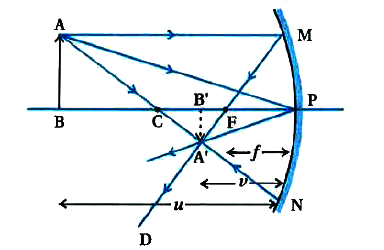Discuss sign convention of distances for reflection by spherical mirror and refraction by spherical lens. Solution in Gujrati
The distances object distance (u), image distance (u), focal length (f), radius of curvature (R) are measured from pole for spherical mirror and from optical centre for spherical lens.
Sign convention of distances is as following :
(1) All distances are measured from the pole of the mirror or the optical centre of the lens.

(2) The distances measured in the same direction as the incident light are taken as positive and those measured in the direction opposite to the direction of incident light are taken as negative.
(3) The heights measured upwards with respect to X-axis and normal to the principal axis (X-axis) of the mirror/lens are taken as positive. The heights measured downwards are taken as negative.
Topper's Solved these Questions
- RAY OPTICS AND OPTICAL INSTRUMENTSBook:KUMAR PRAKASHANChapter:RAY OPTICS AND OPTICAL INSTRUMENTSExercise:SECTION - A (TRY YOURSELF)
Explore 74 Videos
- RAY OPTICS AND OPTICAL INSTRUMENTSBook:KUMAR PRAKASHANChapter:RAY OPTICS AND OPTICAL INSTRUMENTSExercise:SECTION-B (NUMERICALS)(NUMERICAL FROM TEXTUAL ILLUSTRATIONS)
Explore 17 Videos
- MOVING CHARGES AND MAGNETISMBook:KUMAR PRAKASHANChapter:MOVING CHARGES AND MAGNETISMExercise:SECTION D (MCQs ASKED IN COMPETITIVE EXAMS)
Explore 34 Videos
- SAMPLE QUESTION PAPER Book:KUMAR PRAKASHANChapter:SAMPLE QUESTION PAPER Exercise:PART-B SECTION-C
Explore 5 Videos
Similar Questions
Give range of wavelength of visible light.
View SolutionSuppose that the lower half of the concave mirror.s reflecting surface as shown in figure is covered with an opaque (non-reflective) material. What effect will this have on the image of an object placed in front of the mirror ?

View SolutionElectric charge Q having mass M moves on a circular path of radius R with velocity →v, perpendicular to uniform magnetic field B. When a particle completes one revolution, work done by the field is _______
View SolutionTwo charges –q and +q are located at points (0, 0, –a) and (0, 0, a), respectively.
(a) What is the electrostatic potential at the points (0, 0, z) and (x, y, 0) ?
(b) Obtain the dependence of potential on the distance r of a point from the origin when r/a>>1 .
(c) How much work is done in moving a small test charge from the point (5,0,0) to (–7,0,0) along the x-axis? Does the answer change if the path of the test charge between the same points is not along the x-axis?
View SolutionState and explain sign conventions used in spherical mirrors.
View SolutionSPHERICAL MIRROR & SIGN CONVENTION
View SolutionWrite the sign conventions for spherical mirrors.
View SolutionWhat is the Cartesian sign convention used for spherical mirrors?
View SolutionWhat is the Cartesian sign convention used for spherical mirrors ?
View SolutionWhat are the Cartesian sign conventions for a spherical mirror?
View SolutionGive the Cartesian sign convention for measuring distances in spherical mirrors and lenses.
View Solutionगोलीय दर्पणों के लिए कार्तीय चिह्न परिपाटी को समझाइये |
View SolutionWhat is the Cartesian sign convention used for spherical mirrors?
View SolutionWhat are the Cartesian sign conventions for a spherical mirror?
View SolutionWrite the sign conventions for spherical mirrors.
View Solution

